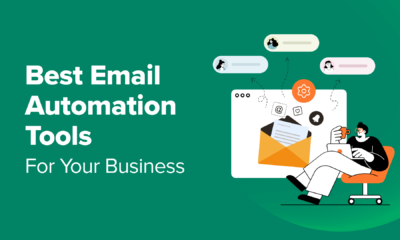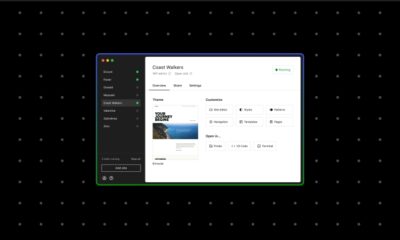MARKETING
Better reporting can improve email performance
Whether you think of email as an art, a science or both (as I do), there’s no escaping the reality that email is a numbers game through and through. Knowing which numbers (or metrics) to track will help you assess and continually optimize your email program’s performance and help you find useful solutions to improve it.
But that’s only the beginning. Numbers need context to give them meaning. That’s where effective reporting comes into play.
Get the daily newsletter digital marketers rely on.
Six ways email reporting builds your email program
Although it’s a key component of successful email marketing, email reporting can be a major challenge for many email teams. Reporting often takes a backseat when the email team has one person on it, or the team manages many other channels besides email.
But when you do reporting right, your reports can help you drive success in six ways:
- Track trends: Reporting, especially when done at several time intervals such as weekly, monthly, yearly, and year-over-year, will help you see where your numbers are trending up or down.
- Generate insights: Your reports will include your insights, based on these trends, into diagnosing problems and suggesting ways to improve your program or new areas to explore.
- Budget and plan effectively: Regular reports will help you see if you’re spending your current budget on things that work and highlight areas where you might need to seek additional funding to close gaps or move your program forward.
- Drive testing: The insights you gain from regular reporting can also highlight areas you want to test. This goes way beyond a one-off subject line or call-to-action testing. Instead, your reporting can guide tests in message content, design, strategy and other high-level areas.
- Inform leadership: An in-depth, organized report with figures, analysis and insights keeps your leadership clued into your email performance. Your executives will be more likely to read your reports if they know they’ll learn valuable information, not just stare at columns of numbers presented without context.
- Show email’s value to everyone: Reporting helps everyone from your email team understand how email contributes to the company’s goals and bottom line. When everyone understands this value, you can more easily build a business case for sustained or additional funding.
As I noted, email reporting is often something that marketers leave to the last minute. That doesn’t give you much time to study your numbers, to think about what they mean in the long run, or how you could use them to improve or expand your email program.
Good reporting forces you to evaluate what the numbers tell you, whether you are compiling a presentation for your senior executives, prepping for your weekly team meeting or summing up what you know as a one-person email department.
You’ll delve below the surface, ask questions and look for answers in your data and use what you find to do email better. You’re not simply listing numbers on a page or in a PowerPoint and filing it away.
Email reporting: Three insights into the state of play today
As I’ve learned in working with clients, everyone does email reporting a little differently. Some marketing teams do all the work themselves. Others have dedicated insight, data or business intelligence units that can do their work.
Many email marketers who create their reports themselves have just enough time to look at the high-level numbers they see in their ESP dashboards – the campaign-by-campaign opens, clicks, and (maybe) conversions.
The heart of email reporting is what you do with the numbers – how you analyze them, what insights you draw from them and how you use them to improve your email program.
Two recent surveys primarily of UK email marketers show the wide range of treatments email reporting receives.
1. Time spent on email marketing is increasing slowly
Econsultancy’s 2019 Email Marketing Industry Census found that 35% of email marketers spent more than two hours of their regular workweek on email reporting. Although 7% of marketers said they spent no time on reporting, 29% spent 2-8 hours, while 6% spent more than eight hours.
That continues a slow uptick in time spent on reporting over the last few years. In the 2017 Census, for example, 25% spent more than two hours on reporting.
Is this good news or does it mean reporting is getting harder to do?
Given how many email platforms now include campaign reporting in their dashboards, thus making the numbers easier to access, I’d like to assume that means more marketers are looking at those numbers and using them to compile even basic reports. And a basic report is better than nothing – it’s the first step toward compiling a really useful analysis.
2. Marketers are (somewhat) confident about their reporting ability
According to the Data & Marketing Association’s 2021 Email Tracker, 54% of marketers say their companies have a “leading” or “good” level of sophistication in their ability to analyze performance, a key component of email reporting.
That’s just slightly behind their confidence in creating email strategy (62%) and creative content (58%). Again, 6% of marketers said their companies don’t analyze email performance.
3. Marketers struggle with reporting
We know from our own client work and from anecdotal and survey results that many don’t have time to do the in-depth analysis that a good email report needs.
Easy access to campaign-level metrics like open, click and conversion rates and inbox performance (unsubscribes, bounces, delivery rates and inbox placement where available) gives them enough data to compile a simple performance report but not the deep-dive analysis needed to understand what’s happening and how to use the data to improve their programs.
Having an email system that makes reporting easy should be a factor in choosing an ESP. The ideal setup automates as much of the data compilation as possible. This reduces the drudgery of manually importing data from spreadsheets and creating visuals for presentations.
In the work my consultancy does for our clients, we pull data from ESPs, e-commerce systems, CRMs, Google Analytics and other integrated data providers into an Excel file that feeds into a PowerPoint presentation. As long as we can pull data into a master Excel document, it will propagate automatically in PowerPoint.
Thus we spend less time adding numbers and more time reviewing and analyzing the numbers and coming up with useful insights and trends. This gives you numbers and context you can cite quickly as well as an official document to pass on to senior executives and to archive for our clients’ own research and planning.
Items to include in your email report
What you include will vary by your brand, the kind of email marketing you do, your vertical, your email goals and strategies and other variables. But these sections should be part of most reports:
1. Essential performance data
This includes campaign-level data involving both process metrics (email activity) and business metrics (conversions, number of sales, average basket value, average or median revenue per email and other goal-oriented metrics.
2. Historical data and trends
These indicate trends, ideally week-over-week, month-over-month and year-over-year comparisons. Include data for list growth, campaign metrics, all of your automated email programs and other relevant data.
Besides the usual performance data you can pull from your ESP and other platforms, crunch the numbers in several different ways to give you an expanded view:
- List growth: Include both your total emailable list (all of the active email addresses in your audience, not including unsubscribers, spam complainers, long-term inactive addresses and others) plus new subscribers, new unsubscribers and your subscriber churn (net growth or loss) during the measurement period.
- Reach analysis: This reviews the percentage of contacts who acted on at least one email campaign over a set period. It includes both open reach (the percentage who opened at least one email) and click reach (the percentage who clicked at least once in the same time period), but both send and purchase reach can also be used.
3. Insights
Here you extrapolate what the data means. Provide context such as extenuating circumstances, changes in your audience or email strategy, external events that affect performance and other enlightening information.
4. Hypotheses to test
Your email data influences your testing program. So, look at things you could test for, such as frequency, content or segmentation strategy, audiences and more.
5. Questions and concerns
Separate from insights, use this space to highlight issues that the numbers reveal, such as declining performance of a specific email program, increase in inactivity or challenges in acquisition.
6. Recommendations
Ideas for improving performance using both capabilities you have in your current technology or outlining how new technology could help you achieve specific goals.
7. Screenshots of recent email campaigns
These visuals keep people in the loop, like your senior executives who don’t monitor your email campaigns as closely as you and your team do. And – let’s be honest – it lets you show off your best work, too.
Report it now, use it later
The time you put in now on your email reporting gives you an advantage later when the time comes to work on your email budget, revamp your email goals and strategies and even help you find a new email vendor as your program grows.
You’ll be a step ahead because you’ve done the analytics, identified your challenges and opportunities, and answered tough questions. Your reports will give you material to guide your steps and choose the right strategies and tactics that will help you achieve your goals.
My hope here is that if your own email reporting practices could use a tune-up, you’ll use the background information and practical advice I provide here to improve your own email reports. And if you’re proud of your email reports and how you incorporate them into your everyday email practices, I would love to hear about it!
Opinions expressed in this article are those of the guest author and not necessarily MarTech. Staff authors are listed here.




















You must be logged in to post a comment Login